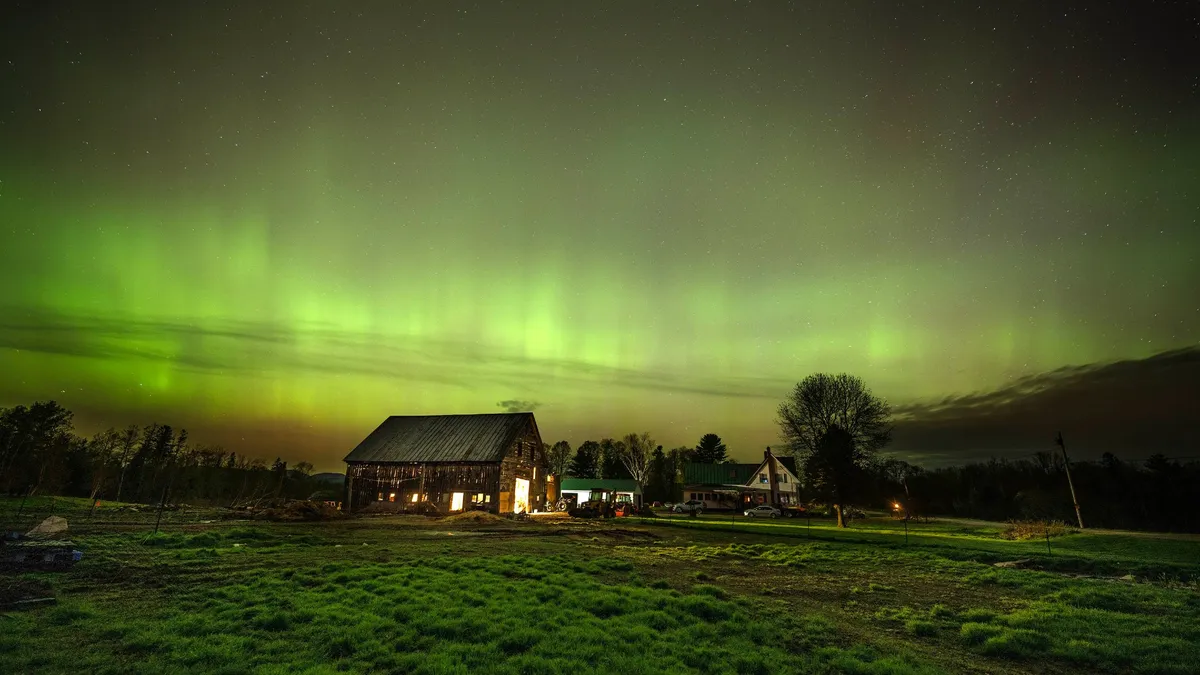
I'll never forget the night of May 10, 2024. I was enjoying dinner with a friend, discussing the unlikely possibility of witnessing the northern lights in Northeast Ohio. This conversation was unprecedented for me, as the aurora borealis is typically associated with more northern latitudes. It all began earlier that week when I was assigned to write one of my first ever stories about space weather triggered by the sun's activity. As a meteorologist, I had not delved much into this topic, but the more I learned, the more fascinated I became with the idea that solar flares from sunspot clusters—approximately 93 million miles (149.60 million kilometers) away—could have significant impacts on Earth.
On Mother's Day Weekend, the National Oceanic and Atmospheric Administration's (NOAA) Space Weather Prediction Center (SWPC) issued a geomagnetic storm watch for a powerful solar event. Little did I know that I would be documenting a geomagnetic storm destined to make history. The May 2024 solar storm, also referred to as the Gannon storm, has now been classified by NOAA as one of the most noteworthy solar events in history, and potentially the most powerful documented this century. This remarkable event included a series of intense solar flares occurring from May 8 to May 11, 2024, originating from a massive sunspot group that was measured to be 17 times wider than Earth’s diameter.
During this time frame, NOAA recorded at least eight coronal mass ejections (CMEs), which are enormous bursts of plasma and magnetic fields ejected from the sun. These CMEs led to the development of extreme geomagnetic storm (G5) conditions, which is the highest classification on NOAA’s space weather scale. According to Mike Cook, Space Weather Lead at MITRE Corporation, this storm was a remarkable event that allowed many people, particularly those in regions that typically do not experience it, to witness the aurora.
While photos of the northern lights flooded social media and made headlines worldwide, the Gannon storm also served as a critical reminder of the sun's ability to produce disruptive events that can heavily impact our critical infrastructure. NOAA's SWPC was praised for providing timely warnings ahead of the solar storm, enabling operators of essential services—such as power grids—to take necessary precautions that ultimately prevented a potential electric disaster. Clinton Wallace, director of NOAA's SWPC, emphasized that their ongoing efforts aim to ensure protection for our infrastructure against such storms.
Thanks to more than a decade of planning and teamwork, those managing crucial systems like power, agriculture, and satellites were able to mitigate most of the damage from the May 2024 storm. Wallace noted, "Being ready isn't just helpful; it's essential." However, like with hurricanes and severe weather events, some impacts were still felt, even with thorough preparations.
Tamitha Skov, a retired research scientist and space weather professor at Millersville University in Pennsylvania, highlighted both the positive and negative outcomes of the storm. While the North American power grid demonstrated impressive resilience against the storm, the agriculture sector experienced vulnerabilities, particularly with GPS systems that assist in guiding tractors. The Gannon storm exposed how integrated GPS technology is in modern farming practices, and a loss of satellite signals can disrupt the entire agricultural industry.
Skov pointed out that while a brief outage may not seem significant, if it occurs during critical planting or harvest seasons, the repercussions for crop yields can be severe. The storm's effects are often amplified during equinoxes, which coincide with key agricultural activities.
The Gannon storm has sparked a greater public interest in space weather. Social media platforms and news outlets have seen a surge in discussions and posts about geomagnetic storms. Aurora chasers are just as enthusiastic as storm chasers, and scientists see this growing curiosity as an excellent opportunity to educate the public about space weather phenomena. As Kelly Korreck, a program scientist at NASA Headquarters, noted, many people are now asking questions about the aurora, its appearance, and its underlying science.
Despite the wealth of new knowledge gained from the Gannon storm, scientists acknowledge that there is still much to learn. Although such powerful storms are not frequent, the potential for even stronger events in the future remains a possibility. Shawn Dahl, NOAA's SWPC Service Coordinator, emphasized the need for the public to understand that a power blackout could still occur due to future storms of similar or greater intensity. Increased awareness among the press and emergency management authorities about space weather is a positive development, aiding in the preparedness and resilience of our nation.